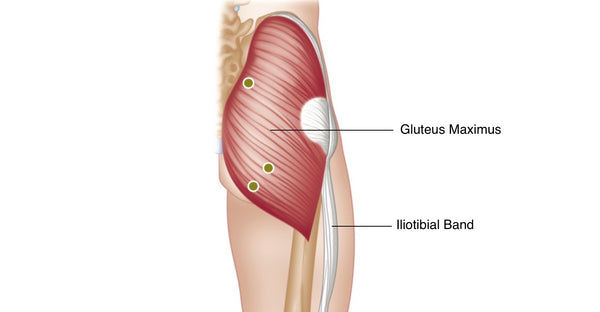Trigger Point Therapy - Snapping Hip Syndrome
Snapping Hip Syndrome - Releasing Trigger Points in Gluteus Maximus
Snapping hip syndrome is a condition where a snapping or popping sensation is felt in the hip with hip flexion and extension
It is most commonly caused by a tendon snapping over a bony prominence. This syndrome may present with or without pain and is particularly prevalent in dancers.
External Snapping
External snapping hip syndrome can be the result of a tight ‘Iliotibial band’ (ITB) or gluteus maximus tendon snapping over the greater trochanter of the femur.
When landing from a jump, running, climbing or squatting these tendons are forced over the bony prominence of the greater trochanter. This can cause inflammation of the muscle and tendon.
Internal Snapping
Internal snapping syndrome may be caused by the iliopsoas tendon snapping over the iliopectineal eminence of the hip.
In more rare cases, tearing of the cartilage (labral tears) of the hip joint may cause snapping as well.
Cause of Injury
Tight ITB or gluteal muscles. Tight iliopsoas muscle. Labral tear.
Signs and Symptoms
Snapping sensation in the hip. May or may not present with pain (more commonly reported as discomfort).
Complications if Not Treated
Snapping hip syndrome can lead to irritation and possible bursitis if left untreated. The inflamed muscle becomes tight and can cause stress on other muscles as well.
Immediate Treatment
RICER programme. Anti-inflammatory medication.
Rehabilitation and Prevention
Rehabilitation starts with stretching and strengthening the muscles of the hip. A balance in strength and flexibility of all the muscles will help prevent snapping hip syndrome.
Proper warm-up of the hip muscles is important before beginning any activity that involves flexion or extension to make sure the muscles are adequately prepared.
It is also important to maintain fitness levels while resting, using activities that do not aggravate the affected area.
Long-Term Prognosis
Snapping hip syndrome seldom requires more than the initial treatment and rehabilitation to recover fully.
Only in very rare cases surgical intervention may be required to correct the problem.

Trigger Points
Trigger points are often at the root cause of snapping hip syndrome. Typically developed as a result of repetitive / overuse, trigger points cause their host muscle to become shorter, tighter and less efficient.
Look for trigger points in the ITB, Gluteus, and Psoas muscles. Incorporate stretching especially with psoas to help accelerate the treatment.
Find a Trigger Point Professional in your area
More Articles About Hip Pain and Trigger Points
Dry Needling for Trigger Points
Certify as a Trigger Point Therapist
NAT Online Trigger Point Courses:
This trigger point therapy blog is intended to be used for information purposes only and is not intended to be used for medical diagnosis or treatment or to substitute for a medical diagnosis and/or treatment rendered or prescribed by a physician or competent healthcare professional. This information is designed as educational material, but should not be taken as a recommendation for treatment of any particular person or patient. Always consult your physician if you think you need treatment or if you feel unwell.
About Niel Asher Education
Niel Asher Education (NAT Global Campus) is a globally recognised provider of high-quality professional learning for hands-on health and movement practitioners. Through an extensive catalogue of expert-led online courses, NAT delivers continuing education for massage therapists, supporting both newly qualified and highly experienced professionals with practical, clinically relevant training designed for real-world practice.
Beyond massage therapy, Niel Asher Education offers comprehensive continuing education for physical therapists, continuing education for athletic trainers, continuing education for chiropractors, and continuing education for rehabilitation professionals working across a wide range of clinical, sports, and wellness environments. Courses span manual therapy, movement, rehabilitation, pain management, integrative therapies, and practitioner self-care, with content presented by respected educators and clinicians from around the world.
Known for its high production values and practitioner-focused approach, Niel Asher Education emphasises clarity, practical application, and professional integrity. Its online learning model allows practitioners to study at their own pace while earning recognised certificates and maintaining ongoing professional development requirements, making continuing education accessible regardless of location or schedule.
Through partnerships with leading educational platforms and organisations worldwide, Niel Asher Education continues to expand access to trusted, high-quality continuing education for massage therapists, continuing education for physical therapists, continuing education for athletic trainers, continuing education for chiropractors, and continuing education for rehabilitation professionals, supporting lifelong learning and professional excellence across the global therapy community.

Continuing Professional Education
Looking for Massage Therapy CEUs, PT and ATC continuing education, chiropractic CE, or advanced manual therapy training? Explore our evidence-based online courses designed for hands-on professionals.



















